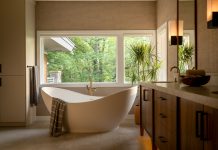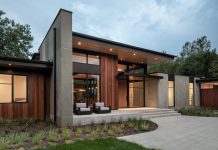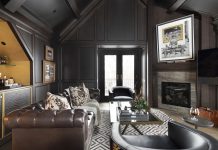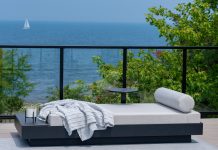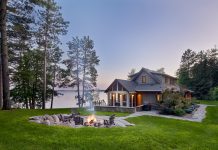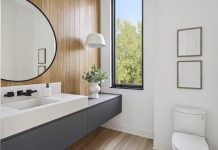In 1906, a group of 25 Presbyterian families established a summer retreat on Crane Island in the southwest corner of Lake Minnetonka.
They cleared the excess brush, constructed 13 small cottages, and eventually built a tennis court at the center of the isle. Each summer, the families would arrive via ferry or rowboat, and each fall they would pack up their Bibles, hymnals, croquet balls, and picnic baskets and return to the city. The island was only a short distance from the mainland and just 25 miles from downtown Minneapolis, but the quiet pace must have made it seem like civilization elsewhere didn’t exist.

Today, Crane Island has telephones and electrical service. There are no cars or trucks, but speedboats and pontoons are moored at the docks of many homes on the island. Some of the original cottages remain, and the island was added to the National Register of Historic Places years ago, yet new construction has not been prohibited. Officially, the island is part of the city of Minnetrista.

Nonetheless, it retains a timeless quality: “It’s one of those places where, standing in the middle of the clearing in the center of the island, it could still be 1910,” says residential designer David Heide. “There’s a magical quality about the island. And there just aren’t that many places like that left in the world.”
Heide, principal of David Heide Design Studio, has visited Crane Island several times and designed homes for clients there. Most recently, he worked with a couple who had purchased three undeveloped lots and wanted to build a cozy retreat where they could go to escape life in Minneapolis—without a lengthy drive. “We liked the idea that it had the feeling of being away,” says the client, who lived for many years in New York and spent summers in Sag Harbor. “The island reminded me of New England. We loved the feel. And the fact that it was just a 30-minute drive and a five-minute boat ride away from our home in the city made it even more perfect.”
Given the quaintness of the island atmosphere, the clients wanted a place that fit the environment—both natural and cultural. They had hired Heide to remodel their home on Lake of the Isles in Minneapolis largely because of the designer’s sensitivity to historic details and his understanding of what makes a home sumptuous and comfortable. The Crane Island house didn’t need to be big or fancy, but the clients wanted quality, beauty, and comfort in their home-away-from-home.

Heide designed a 2,900-square-foot two-story home to meet their needs. With a wrap-around porch, shed dormers, and a fieldstone chimney poking up from the center, the cottage, completed last fall, looks like it was built more than a century ago. “The client specifically wanted a house that appeared to have been there for 100 years and that was almost indistinguishable from other houses on the island,” Heide says.
To achieve that look took some sleight of hand. Study an old house and you’ll see that the tops of the windows nearly reach the eaves, Heide says. The residences sit lower on their foundations and the floors are thinner. Getting the proportions of the Crane Island cottage to appear a century old, for example, required hanging the floor joists into the basement space, rather than resting them on top of the foundation. Because of this, the cottage appears to sit closer to the ground.

Interior spaces are dominated by wood and windows. Much of the woodwork is painted white, but the fir floors and ceilings are finished with a shellac that gives them a warm glow. The interior revolves around a dry-stack stone fireplace that rises two stories, flanked by an inglenook on one side and a staircase on the other. Two carefully chosen reclaimed trees with knots and even branches that were incorporated into the staircase design stand sentry at the top and bottom of the steps. “It reminds you of the nature surrounding you,” Heide says. “It’s a touch that’s common in Japanese architecture.”
The small kitchen includes cabinets salvaged from the client’s Lake of the Isles home, repainted and fitted with forged-iron hardware. Meals can be prepared on an old butcher-block-topped bench placed in the center of the kitchen or on the Coast Green granite countertops. The same granite was used behind the stovetop, and a custom-made wrought-iron rack provides convenient storage for pots, pans, and bakeware. A cabinet with glass doors is fitted with shelves on top for china and a pass-through to the dining room below. Unlike in modern homes, the kitchen and the dining areas are separated. “Not everybody wants an open-living concept,” Heide notes. “There are those who understand and admire the proportions and divisions of an historic house and who desire that kind of arrangement.”

The upstairs contains a master suite with an adjoining bathroom, as well as two guest rooms and a bath. Built-in bookshelves and cabinets hold volumes for reading on rainy days as well as other distractions. The cut of the dormers gives it a compact feeling.
This summer, the island’s current residents will celebrate the 110th anniversary of the Presbyterian association that established the Crane Island Community. There will be a pig roast, lemonade, bouquets of wildflowers, and lots of talk about how wonderful it is to spend summers on the island. Some of the homes may be brand new, but in 110 years, the way of life hardly seems to have changed at all.

Designed by David Heide Design Studio




